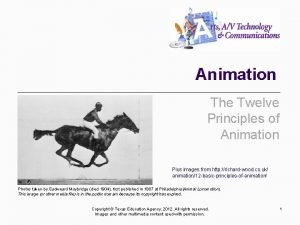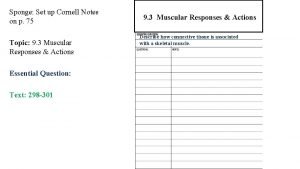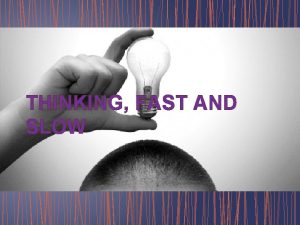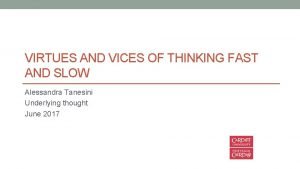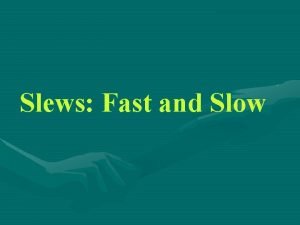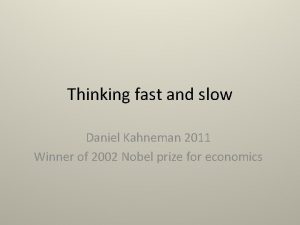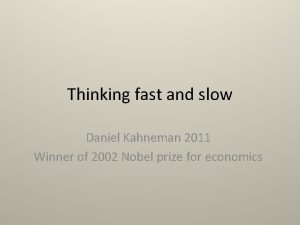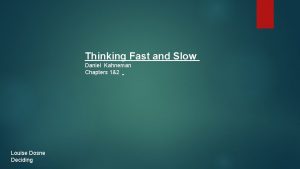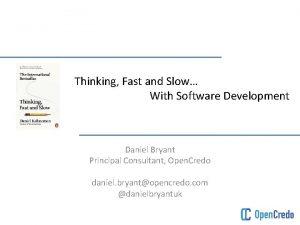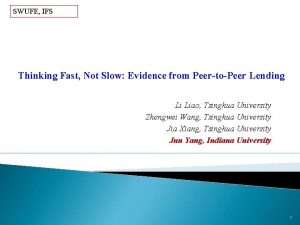THINKING FAST AND SLOW Highlights from a long













- Slides: 13

THINKING, FAST AND SLOW

Highlights from a long intellectual collaboration

Two broad ideas about human nature (from the 1970 s) 1) People are generally rational and their thinking is normally sound. 2) Emotions such as fear, affection and hatred explain most of the occasions on which people depart from rationality.

Current broad ideas about human nature • The mind – especially System I – appears to have special aptitude for the construction and interpretation of stories. . … with agents, personalities, habits and abilities. (p. 29) • A general ‘law of least effort’ applies to cognitive as well as physical exertion … Laziness is built deep into our nature. (p. 35)

Paying attention to the world around us is hard! Watch and Count Carefully! https: //www. youtube. com/watch? v=ub. NF 9 QNEQLA

Which line is longer?

Is it as easy to correct cognitive illusions as visual illusions?

An even cooler optical illusion • http: //www. anopticalillusion. com/2015/09/terror-subterraby-roger-shepard/

What is the relationship between selfcontrol and cognitive function? I want it now!

Shall We Try Some of these Tests? • Let’s do Add One! https: //www. imusic-school. com/en/tools/online-metronome/ • What does it feel like to have your system ii actively engaged? • Can you resist ego depletion?

Cognitive Reflection Test • by Shane Frederick (2005) (1) A bat and a ball cost $1. 10 in total. The bat costs $1. 00 more than the ball. How much does the ball cost? _____ cents (2) If it takes 5 machines 5 minutes to make 5 widgets, how long would it take 100 machines to make 100 widgets? _____ minutes (3) In a lake, there is a patch of lily pads. Every day, the patch doubles in size. If it takes 48 days for the patch to cover the entire lake, how long would it take for the patch to cover half of the lake? _____ days

Answers (1) 5 cents (not 10) (2) 5 minutes (not 100) (3) 47 days (not 24) Extra explanation • (1) A bat and a ball cost $1. 10 in total. The bat costs $1. 00 more than the ball. How much does the ball cost? _____ cents • Say the ball costs X. Then the bat costs $1 more, so it is X + 1. So we have bat + ball = X + (X + 1) = 1. 1 because together they cost $1. 10. This means 2 X + 1 = 1. 1, then 2 X = 0. 1, so X = 0. 05. This means the ball costs 5 cents and the bat costs $1. 05 • (2) If it takes 5 machines 5 minutes to make 5 widgets, how long would it take 100 machines to make 100 widgets? _____ minutes • If it takes 5 machines 5 minutes to make 5 widgets, then it takes 1 machine 5 minutes to make 1 widget (each machine is making a widget in 5 minutes). If we have 100 machines working together, then each can make a widget in 5 minutes. So there will be 100 widgets in 5 minutes. • (3) In a lake, there is a patch of lily pads. Every day, the patch doubles in size. If it takes 48 days for the patch to cover the entire lake, how long would it take for the patch to cover half of the lake? _____ days • Every day FORWARD the patch doubles in size. So every day BACKWARDS means the patch halves in size. So on day 47 the lake is half full.

Enriching our vocabulary of judgment and decision-making • Bias – systematic error • Heuristic – rule of thumb, frequently contributes to bias • Availability heuristic • Affect heuristic • Substitution heuristic • Overconfidence bias • • Resemblance bias Propinquity bias Causality bias Priming (reciprocal priming, money priming, exposure priming, etc. ) • Anchors • Sampling effects (source, story, selection)
 Twelve principles of animation
Twelve principles of animation Crash course muscles part 2
Crash course muscles part 2 Fast clock to slow clock synchronization
Fast clock to slow clock synchronization Fast slow opposites
Fast slow opposites Long and short
Long and short Long long long ago there lived a little girl
Long long long ago there lived a little girl Acid fast vs non acid fast
Acid fast vs non acid fast Acid fast vs non acid fast
Acid fast vs non acid fast Features highlights
Features highlights Proposal highlights
Proposal highlights Highlights memorandum
Highlights memorandum Investment highlights
Investment highlights Highlights from the book of isaiah
Highlights from the book of isaiah Highlights from the book of isaiah
Highlights from the book of isaiah
